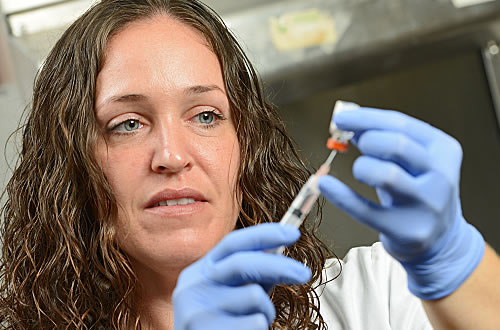Defining Cancer
 Cancer is a term used for diseases in which abnormal cells divide without control and are able to invade other tissues. Cancer cells can spread to other parts of the body through the blood and lymph systems.
Cancer is a term used for diseases in which abnormal cells divide without control and are able to invade other tissues. Cancer cells can spread to other parts of the body through the blood and lymph systems.
Cancer is not just one disease but many diseases. There are more than 100 different types of cancer. Most cancers are named for the organ or type of cell in which they start – for example, cancer that begins in the colon is called colon cancer; cancer that begins in basal cells of the skin is called basal cell carcinoma. Cancer types can be grouped into broader categories. The main categories of cancer include:
Carcinoma – cancer that begins in the skin or in tissues that line or cover internal organs.
Sarcoma – cancer that begins in bone, cartilage, fat, muscle, blood vessels, or other connective or supportive tissue.
Leukemia – cancer that starts in blood-forming tissue such as the bone marrow and causes large numbers of abnormal blood cells to be produced and enter the blood.
Lymphoma and myeloma – cancers that begin in the cells of the immune system.
Central nervous system cancers – cancers that begin in the tissues of the brain and spinal cord.
Origins of Cancer
All cancers begin in cells, the body’s basic unit of life. To understand cancer, it’s helpful to know what happens when normal cells become cancer cells.
The body is made up of many types of cells. These cells grow and divide in a controlled way to produce more cells as they are needed to keep the body healthy. When cells become old or damaged, they die and are replaced with new cells.
However, sometimes this orderly process goes wrong. The genetic material (DNA) of a cell can become damaged or changed, producing mutations that affect normal cell growth and division. When this happens, cells do not die when they should and new cells form when the body does not need them. The extra cells may form a mass of tissue called a tumor.
Not all tumors are cancerous; tumors can be benign or malignant.
Benign tumors are not cancerous. They can often be removed, and, in most cases, they do not come back. Cells in benign tumors do not spread to other parts of the body.
Malignant tumors are cancerous. Cells in these tumors can invade nearby tissues and spread to other parts of the body. The spread of cancer from one part of the body to another is called metastasis. Some cancers do not form tumors. For example, leukemia is a cancer of the bone marrow and blood.
Some cancers do not form tumors. For example, leukemia is a cancer of the bone marrow and blood.
Types of Cancer
Bladder Cancer
Breast Cancer
Colon and Rectal Cancer
Endometrial Cancer
Kidney (Renal Cell) Cancer
Leukemia
Lung Cancer
Melanoma
Non-Hodgkin Lymphoma
Pancreatic Cancer
Prostate Cancer
Thyroid Cancer
Bladder Cancer
Cancer that forms in tissues of the bladder (the organ that stores urine). Most bladder cancers are transitional cell carcinomas (cancer that begins in cells that normally make up the inner lining of the bladder). Other types include squamous cell carcinoma (cancer that begins in thin, flat cells) and adenocarcinoma (cancer that begins in cells that make and release mucus and other fluids). The cells that form squamous cell carcinoma and adenocarcinoma develop in the inner lining of the bladder as a result of chronic irritation and inflammation.
Breast Cancer
Cancer that forms in tissues of the breast, usually the ducts (tubes that carry milk to the nipple) and lobules (glands that make milk). It occurs in both men and women, although male breast cancer is rare.
Click here to learn more about breast cancer risk factors, signs and symptoms, screening, prevention, and more.
Colon and Rectal Cancer
Cancer that forms in the tissues of the colon (the longest part of the large intestine). Most colon cancers are adenocarcinomas (cancers that begin in cells that make and release mucus and other fluids). Cancer that forms in the tissues of the rectum (the last several inches of the large intestine closest to the anus).
![]()
Endometrial Cancer
Cancer that forms in the tissue lining of the uterus (the small, hollow, pear-shaped organ in a woman’s pelvis in which a fetus develops). Most endometrial cancers are adenocarcinomas (cancers that begin in cells that make and release mucus and other fluids).
![]()
Kidney Cancer
Cancer that forms in tissues of the kidneys. Kidney cancer includes renal cell carcinoma (cancer that forms in the lining of very small tubes in the kidney that filter the blood and remove waste products) and renal pelvis carcinoma (cancer that forms in the center of the kidney where urine collects). It also includes Wilms tumor, which is a type of kidney cancer that usually develops in children under the age of 5.
![]()
Leukemia
Cancer that starts in blood-forming tissue such as the bone marrow and causes large numbers of blood cells to be produced and enter the bloodstream.
![]()
Lung Cancer
Cancer that forms in tissues of the lung, usually in the cells lining air passages. The two main types are small cell lung cancer and non-small cell lung cancer. These types are diagnosed based on how the cells look under a microscope.
![]()
Melanoma
A form of cancer that begins in melanocytes (cells that make the pigment melanin). It may begin in a mole (skin melanoma), but can also begin in other pigmented tissues, such as in the eye or in the intestines.
![]()
Non-Hodgkin Lymphoma
Any of a large group of cancers of lymphocytes (white blood cells). Non-Hodgkin lymphomas can occur at any age and are often marked by lymph nodes that are larger than normal, fever, and weight loss. There are many different types of Non-Hodgkin lymphoma. These types can be divided into aggressive (fast-growing) and indolent (slow-growing) types, and they can be formed from either B-cells or T-cells. B-cell non-Hodgkin lymphomas include Burkitt lymphoma, chronic lymphocytic leukemia/small lymphocytic lymphoma (CLL/SLL), diffuse large B-cell lymphoma, follicular lymphoma, immunoblastic large cell lymphoma, precursor B-lymphoblastic lymphoma, and mantle cell lymphoma. T-cell Non-Hodgkin lymphomas include mycosis fungoides, anaplastic large cell lymphoma, and precursor T-lymphoblastic lymphoma. Lymphomas that occur after bone marrow or stem cell transplantation are usually B-cell non-Hodgkin lymphomas. Prognosis and treatment depend on the stage and type of disease. Also called NHL.
![]()
Pancreatic Cancer
A disease in which malignant (cancer) cells are found in the tissues of the pancreas. Also called exocrine cancer.
![]()
Prostate Cancer
Cancer that forms in tissues of the prostate (a gland in the male reproductive system found below the bladder and in front of the rectum). Prostate cancer usually occurs in older men.
![]()
Thyroid Cancer
Cancer that forms in the thyroid gland (an organ at the base of the throat that makes hormones that help control heart rate, blood pressure, body temperature, and weight). Four main types of thyroid cancer are papillary, follicular, medullary, and anaplastic thyroid cancer. The four types are based on how the cancer cells look under a microscope.
![]()
Courtesy of the National Cancer Center at the National Institutes of Health


 When Kim was diagnosed with stage 4 serous carcinoma ovarian cancer on August 9, 2022, she was hospitalized at St. Mary’s—an overwhelming start to a life-changing journey. But from the very beginning, one constant stood out: her connection with Dr. Krista Isaac. “She’s been more than just my oncologist,” Kim said. “She’s been a constant source of comfort, someone who listens to my fears, answers every question, and truly looks out for me.”
When Kim was diagnosed with stage 4 serous carcinoma ovarian cancer on August 9, 2022, she was hospitalized at St. Mary’s—an overwhelming start to a life-changing journey. But from the very beginning, one constant stood out: her connection with Dr. Krista Isaac. “She’s been more than just my oncologist,” Kim said. “She’s been a constant source of comfort, someone who listens to my fears, answers every question, and truly looks out for me.”